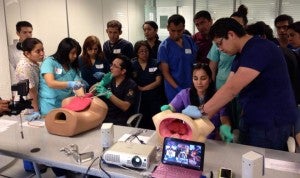In Mexico, maternal mortality continues to be a public health problem. Throughout the country, the burden of maternal mortality varies greatly between different locations. The three states with the highest maternal mortality ratio are Guerrero, Oaxaca, and Chiapas. The main causes of maternal mortality continue to be hypertensive pregnancy disorders and postpartum haemorrhage.

In order to help meet the needs of these underserved and high-burdened states, newly graduated medical students are required to oversee a low-income community for an internship year after completing medical school. However, this means that the most inexperienced clinicians are caring for the most vulnerable with restricted access to other medical assistance.
Based on these worrisome facts, the director of community service at the National University and I decided to organize a three-day course covering pre-eclampsia and postpartum haemorrhage (PPH) for the soon-to-be doctors of the most affected areas in Mexico. We hosted 160 students, which was a big challenge, but an encouraging one.
The first day a very important question was posed to the medical students: “How many of you have seen a woman die from postpartum haemorrhage?” The answer was shocking: half of the medical students had witnessed a maternal death caused by PPH during their short practice.
The students were trained using both e-learning modules and hands-on experience. The PPH and pre-eclampsia/eclampsia e-learning modules were created by the Oxford Maternal and Perinatal Health Institute and Geneva Foundation for Medical Education and Research (GFMER). The three hands-on PPH simulations were key to solidifying knowledge presented in the e-learning modules.
- At the first station, students practiced risk factor assessments and bleeding measurement. A series of clinical cases were posed where risk factors were reviewed. Also, students were handed gauzes and compresses soaked in red liquid to practice assessing what different quantities of blood looked like.
- At the second station, students learned how to build a low cost balloon for uterine tamponade with condoms and Foley catheters. They then practiced inserting the balloon in a pelvis model to treat simulated PPH.
- At the last station, participants were faced with a delivery patient model where they assisted a delivery, practiced shoulder dystocia maneuvers, implemented the active management of the third stage of labour and followed a PPH protocol, which included pharmacological strategies.
Students were asked if they considered the training course interesting and useful and the answer was an overwhelming, yes! Ninety six percent considered it very useful and interesting. One of the most curious comments during the feedback was that although students considered the training adequate for their skill level, 50% thought it should have been given much earlier, since the skills were needed for many cases during medical school.
Overall the course participants and staff had a great time. Hopefully this will become a routine course every year and perhaps available to all medical school students before they finish their career!
Any comments or suggestions, please feel free to e-mail the author at:
